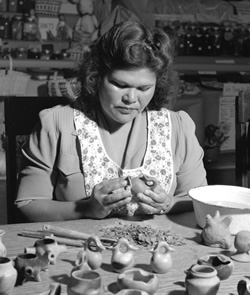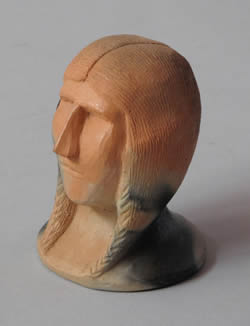People: Edith Welch Bradley

Edith Welch Bradley demonstrating
at the Cherokee Indian Fair.
North Carolina Archives;
North Carolina Department of Tourism
photograph by John H. Hemmer.
With a potter mother, an aunt who taught pottery, the Harris Owls as close family friends, and direct kin to Charlotte Bigmeat and her five daughters, Edith Welch Bradley (1918–1999) grew up surrounded by potters and the pottery process. Her potter mother Maude French Welch (1894–1953) learned her skills in South Carolina from the Catawbas, and upon returning to Cherokee supported the family with her work, with family members assisting. As a child, Edith helped finish the pots by rubbing them smooth. She once competed against her mother at the Cherokee Indian Fair – and won – with miniature versions of each of her mother’s entries.
Edith Welch Bradley (1918–1999) of Birdtown learned pottery from her mother, Maude French Welch (1894–1953), who was born on the Qualla Boundary but moved quite a bit with her family before returning to Cherokee to live and produce pots. “We made our living from mother’s pottery,” Edith recalled. Edith was surrounded by potters and the pottery process. Charlotte Bigmeat was her aunt, and Charlotte Bigmeat’s five daughters were her cousins. Another aunt was pottery teacher Bettie Welch Smith. And while she was not directly related to the Harris-Owls, they were close friends of her mother’s, and Maude Welch sold her pottery through them.1
In 1925, the family left Cherokee to seek factory work, traveling to Rock Hill, S.C., where they observed four of the Catawba tribe’s best potters. Catawba scholar Thomas Blumer noted that the “Catawbas are adamant in their insistence that Maude Welch never worked in clay while visiting in their homes. She merely observed.” Still, such observation is consistent with traditional and familial ways of teaching and learning, and no doubt, Welch was able to absorb what she learned during her stay in South Carolina.2
Edith accompanied her parents when they moved around to find work and remembered their stay in South Carolina. She recalled, “After we moved back to Cherokee, Mama said, ‘Well, I believe I’ll try to make some pottery.’ She made a few canoes and bowls. She sold them and got some more clay.” Her daughter continued, “Every year Mama won first prize for her pottery.” Edith also recalled the financially difficult times, saying that her mother received little for a finished pot. Still, even as the demand for her work grew, Maude Welch was reluctant to raise her prices. Much of her business was a family enterprise. Like many extended pottery families, family members assisted with some of the work. Edith’s father helped by scraping the pottery smooth, and the children helped with finishing. “Many a night we sat up working pots...I rubbed pots for her. I’d rub and rub and rub.” With young, inexperienced hands, there was always a danger of breakage. “We got whipped if we bothered Mama’s pots,” Edith recalled.3
Even as a child, Edith Welch already was familiar with the process of making pottery, including ways of displaying and selling. In a friendly competition against her mother at the Cherokee Indian Fair, Edith won by making miniature versions of each of her mother’s entries. “It was the only time she got beat,” Edith remarked proudly. Her winning work was snapped up by the owner of a pottery shop.4
M. Anna Fariello
Biography excerpted from Cherokee Pottery: From the Hands of our Elders
Published by The History Press, 2011
1. Edith Welch Brady interview by Thomas J. Blumer (1979), Blumer Collection, University of South Carolina-Lancaster.
2. Brady interview; Thomas Blumer, “Catawba Influences on the Modern Cherokee Tradition,” Appalachian Journal 14, no. 2 (Winter 1987), 162.
3. Brady interview; Blumer, “Catawba Influences.”
4. Blumer, “Catawba Influences.”



